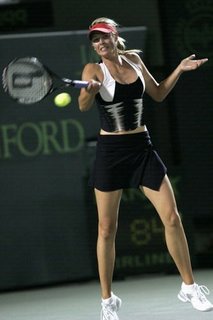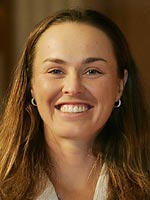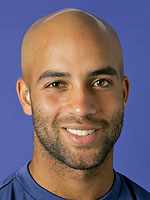
Last year, in an article I wrote prior the the US Open, I questioned whether Andy Roddick had somehow been head-gamed by his lousy record against Roger Federer. This was just a few years after writing another article—a profile of James Blake—on the eve of Roddick's US Open win, which at the time seemed his breakout moment. I labeled him "unconflicted," in contrast to the pre-epic-injury Blake, who back then seemed to be struggling with his motivation.
Oh, how the tables have turned! After losing last night (March 15) to Andreev in three sets at the Pacific Life Open, Roddick seems to be the one struggling, while Blake has suddenly come into his own (he's not going to win the tournament, but I'd bet on him as a semifinalist, as I'd bet on him as a semifinalist in just about any hard-court tournament these day). Blake is riding a streak: he won the Tennis Channel Open just last week. Roddick, meanwhile, looks lost. In fact, I think he knows he's lost.
Here's what I think is going on. A year ago, it dawned on him that, if he wanted to stop losing Wimbledon finals to Federer, he was going to have to add some additional dimensions to his game. He appears to have been working on that. Specifically, he and his coach, Dean Goldfine, seems as if they are attempting to devise a "transitional" game for A-Rod, one that gets him to the net behind very big forehands. All well and good in theory, but none too pretty in execution. Between the service line and the net, Roddick looks awkward, still. My suspicion is that he knows it's not rising to a level that's going to scare Federer. So Andy is getting worried, maybe even prematurely depressed, and it's making him vulnerable to lower-ranked players. He sounds gloomy in press conferences. The guy is extemely smart, and he has a disarming capacity to undercut media concern about his less-the-steller performances (today's LA Times rightly pointed out that A-Rod is using the media as his sort of public shrink). But this only gets the guy so far. His game has not matured since he won that US Open back in 2003. Sure, he'll always be a lock at Wimbledon—the monster serves wins him too many points. Heck, he'll probably win one by default, just by making it to the finals and facing somebody who rode a lucky streak for the fortnight.
But if he intends to remain a top player—as in Top 4—he needs to do something that everybody pretty much agrees that he needs to do.
He needs to go back to Brad Gilbert.
I'm sure Goldfine is a competent coach, but what he's been hired to do for Roddick isn't paying off. The attacking game isn't developing. Gilbert, as far as I can tell, took a different approach. He stuck to fundamentals: huge serve, huge forehand. What he added to the mix was patience, and improved tactical sense, and better use of/covering-up-for a vulnerable backhand. Andy is a cool guy, but he has a tremendously ugly game. Brutally ugly. Gilbert convinced him to embrace that. It won Roddick a US Open. Then, for whatever reason, the relationship soured and Gilbert went away (most think the breakup involved money, lots of money). And Roddick has been in limbo every since.
Federer, once he peaks for a major, plays nearly flawless tennis. Unless he's injured, that's just the way it's going to be for a while. Nadal has perfected a new form of ground game—horrifying, explosive topspin—that offers an alternative to the power game that Federer has so deftly defused in countless others, including Roddick. Blake has finally learned to capitalize on his speed. Then there are all these Russian guys who are just menacingly competitive. What is Roddick going to do in the face of this evolution?
He's got to re-embrace the ugly. He's got to hook back up with Gilbert. If there's anybody who can figure out how to beat Federer on grass or a hard court, and Nadal on clay, it's Gilbert. He must have noticed, for example, that Federer doesn't like to move wide to his backhand. Doesn't Roddick have the gruesomely effective inside-out forehand to give Fed pain on that side over and over?
I firmly believe that A-Rod has the ammunition. Now he just needs the right general to get his head back in the battle.
What about the dollars? If I were Roddick, I'd be thinking that maybe Gilbert was worth his asking price.














